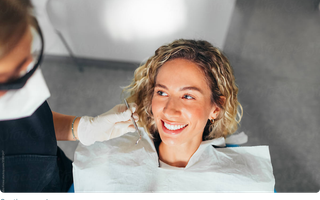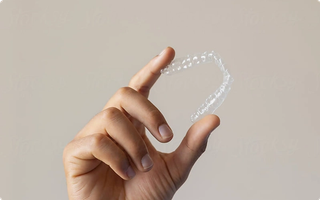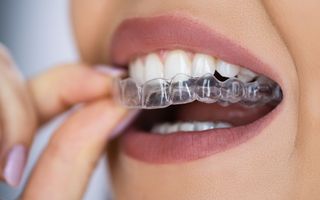
Invisalign®
The clear alternative to metal braces.
Why choose us for Invisalign
Invisalign is the modern and effective technique of using a series of clear plates to realign teeth rather than the traditional, permanently fixed metal braces. Invisalign starts straightening your smile soon after starting so results are seen and enjoyed early on. A great smile can improve your self-confidence and oral health.
How does Invisalign work?
Invisalign uses clear aligners created specifically for your own mouth to gradually and gently move your teeth into place. Every couple of weeks a new, specially modified aligner is worn, moving the teeth little by little until they have straightened into the prescribed position determined by your dentist.
Like traditional braces, Invisalign works by exerting consistent pressure on your teeth to move them slowly into place. Because the aligners change every few weeks, your dentist can target different areas over the time of your treatment.
Depending on your individual treatment plan, you may use as little as seven aligners, or as many as forty. Your dentist will use X-rays, pictures, and impressions to create a precise 3-D image of your teeth and to configure your aligner trays accordingly.
Affordable check-ups and treatments
Payment plans to help you spread the cost
Trusted to deliver outstanding dental care
Made with medical grade thermoplastic which is BPA free and durable.
Precisely engineered to help achieve the perfect smile.
Help maximising your dental extras
How long does treatment take with Invisalign?
Obviously, everybody’s teeth are different, and so the time frame for treatment varies according to the corrections that need to take place. In your initial consultation, your dentist will tell you the likely length of treatment, and how many individual aligners you will need. Treatment can vary between 6 months and 2 years, with the average length of treatment being about a year. In some cases, your teeth may take longer than predicted to align fully. In these instances there may be some additional ‘refinement’ aligners. If needed, these do not cost extra but can add some time to the overall treatment.
Once treatment has concluded, as with most braces systems, a temporary retainer will need to be worn for some time after to stabilise teeth in their new positions. This will be custom made for you once your teeth are aligned.

Does Invisalign treatment hurt?
Invisalign is one of the most comfortable orthodontic options available. The aligners are smooth with no sharp or protruding edges, so they won’t graze or rub in your mouth. While there may be some discomfort with each new aligner, this will fade within a few days. This is simply the result of the pressure of the aligner moving your teeth.
Is Invisalign right for me?
While Invisalign can successfully straighten teeth in a broad range of cases, it is not suitable for every situation. Read more about choosing Invisalign, and come and see us for a comprehensive assessment.
Choosing Invisalign®



Comparing Invisalign® vs braces
Both Invisalign® and braces have the same goal - to straighten and align your teeth for better oral health and a more confident smile. However, they achieve this in different ways.
With braces, your orthodontist will attach semi-permanent brackets to each tooth, which will be attached by a wire that works to slowly move your teeth into place. You will wear these braces until treatment is complete, which is usually 12-24 months. These braces are obvious whenever you open your mouth to eat or speak.
With Invisalign®, you will wear a series of clear trays custom-made for your mouth that will slowly move your teeth into place. You can take the trays out when you eat and drink, or for special occasion photos. It takes about the same amount of time as braces, but Invisalign® is not immediately obvious when you open your mouth - someone would have to be quite close to see the tray.
The right option for you will depend on your specific needs and circumstances. Invisalign® is typically more expensive, but the extra cost may be worth it if you would prefer a more discreet treatment.

What is Invisalign®
Invisalign is the modern and effective technique of using a series of clear plates to realign teeth rather than the traditional, permanently fixed metal braces. Invisalign starts straightening your smile soon after starting so results are seen and enjoyed early on. A great smile can improve your self-confidence and oral health.

Frequently asked questions
Invisalign is one of the most comfortable orthodontic options available. The aligners are smooth with no sharp or protruding edges, so they won’t graze or rub in your mouth. While there may be some discomfort with each new aligner, this will fade within a few days. This is simply the result of the pressure of the aligner moving your teeth.
While Invisalign can successfully straighten teeth in a broad range of cases, it is not suitable for every situation. Read more about choosing Invisalign, and come and see us for a comprehensive assessment.
As treatment plans vary widely between patients, the cost of Invisalign treatment also varies. Find out about the different types of treatment, and our payment options.
For more information, or to book an Invisalign assessment, contact Richmond Fine Dentistry. We’d be happy to help you learn more about Invisalign.
Can't find what you're looking for?
We aim to make looking after your dental health simple. Read our FAQs below, or for anything else, contact us.



